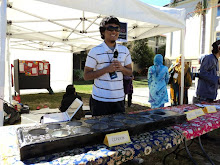Shape
There are many objects in our life that have similar shapes. Books, dictionaries, televisions, computers and papers are of the same shape - rectangle. Balls, water melons, oranges and tomatoes are round. Water bottle and bananas are cylinder.
During the workshop with Anne, we had come up with a village using papers. We created road, houses, buildings and junction using papers by designing many different shapes.
the village in the making..
Symmetry
When a shape can be folded to become another shape, that is symmetry. For example, a rectangle can be folded into two shape. Thus, we consider a rectangle to have two symmetry.
In the workshop, we had the opportunity to try finding how many symmetry the shapes have using a mirror. If the mirror reflects the same shape, so it is symmetry.
Symmetry is a big word for young learners, therefore the introduction of the word should be accompanied by interesting activities. There are many suggestion of activities that teachers can carry out here
Tangrams
Tangram is a puzzle consisting seven flat shapes which can be put together to form shapes. The shapes are rectangle, triangle, parallelogram and trapezium.
a parallelogram
a triangle
a rectangle
Teacher tip-tops:
1- This topic really needs to be done using hands-on activity or games. There is no point for teachers to put more emphasis on explaining the meaning of any words used in the topic. Thus, teacher should prepare a range of activity to reinforce students' understanding.
2- Paper is the most suitable material to cater for all students' need in a lesson of this topic. Students can explore the concept of shape, symmetry and tangram using paper.
.jpg)




0 comments:
Post a Comment